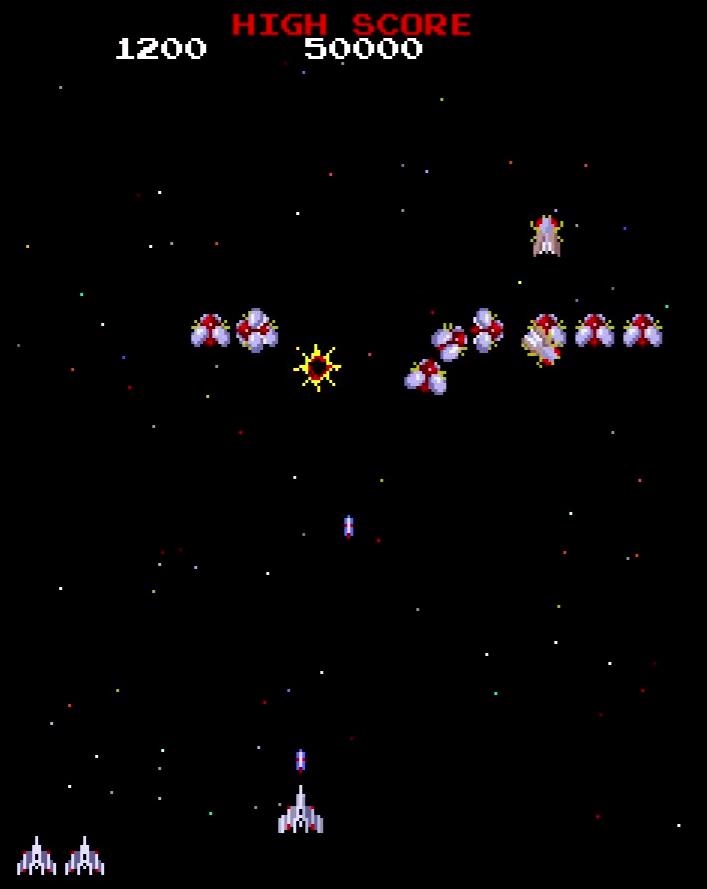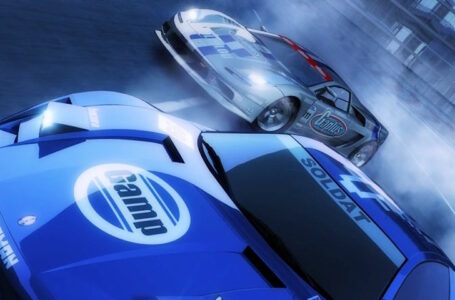2283: The Galaga evolve in Gaplus
As time crept ever onwards towards the dawn of the 24th century, life certainly wasn’t getting any easier for humanity and its United Galaxy Space Force. After the Galaxian-Galaga Wars of 2279 and 2281, the Galaga forces evolved into an even more intelligent form, which became known as the Gaplus.
Naturally somewhat perturbed at having been beaten back by humanity in their previous encounters, the Gaplus set about creating a new empire. It is worth noting, however, that the Gaplus were arguably not the immediate aggressors in what would become known as the Galaxian-Galaga War of 2283.

Instead, one can argue that the conflict was born from fear. Concerned at the rapid expansion of the Gaplus empire, the UGSF developed another new space fighter, this time known as the Ogre Header. The Ogre Header’s unique characteristic was its ability to make use of technology known as Blaster Heads, which incorporated a similar tractor beam to that used by the Galaga in 2281.
Recognising that the UGSF’s new weapon posed a threat to the Gaplus, the Gaplus decided to steal the Blaster Heads technology, which was the event that finally sparked the beginning of all-out war once again.
The Galaxian-Galaga War of 2283 was chronicled in Namco’s 1984 arcade game Gaplus, which, just to confuse matters, is actually the third title in the Galaxian series (with Galaxian³ actually being the fifth despite narratively being first). It’s recognisable as a direct follow-up to Galaga in that it makes use of many of the same mechanics, but runs on enhanced technology. Specifically, it’s the only game other than the rather unusual Phozon to run on Namco’s Phozon hardware.

Gaplus is a little less well-known than Galaxian and Galaga because it didn’t receive nearly as many home ports. In fact, until Namco put together a “demastered” version of the game for its recent Namco Museum Archives Vol. 2 compilation for Nintendo Switch, PlayStation 4, Xbox One and Steam, the only home versions of Gaplus were a Commodore 64 port by Mastertronic and a PC-98 version from Namco themselves.
Gaplus’ fundamental structure is similar to Galaga. As each stage opens, the enemies swoop in from the sides of the screen in formation, gradually forming a convoy at the top of the screen. One notable difference is that some enemies break formation during their initial arrival, swooping down at you for an immediate kamikaze attack rather than waiting until they’re part of the convoy.
As in Galaga, once the enemies are in their convoy, they’ll begin swooping at you, dropping bombs as they do so. Bombs don’t necessarily fly straight downwards in Gaplus, so you’ll need to keep a careful eye on things — thankfully, the Ogre Header has a notable advantage over its predecessor in that it’s capable of moving vertically and diagonally as well as just horizontally, giving Gaplus a notably distinct feeling from Galaga.

Gaplus’ “power up” mechanic is a little different from Galaga’s. Rather than having to gamble a life to double your firepower, you’ll occasionally come across enemies who are holding on to one of the Blaster Heads attachments for your ship. There are a few of these available, with the first you’re likely to encounter being a tractor beam that acts as a reversal of the Galaga’s special attack in the previous game.
Nab the tractor beam Blaster Heads and you’ll be able to capture enemies, which will move into formation with you and become additional firepower. The more Gaplus you capture, the more shots you’ll be able to fire at once — and unlike in Galaga, losing an attached Gaplus isn’t the same as losing a life, making this a much less risky manoeuvre.
Other Blaster Heads power-ups include a drill that can destroy many enemies at once, as well as items that slow down enemies or nullify their shots. Sometimes you’ll even come across Gaplus holding on to components for a new Ogre Header ship; collect all of these and you’ll get an extra life separate from those awarded for attaining high scores.

Gaplus features Challenging Stages similar to many other Namco games from the period. Rather than simply tasking you with destroying entire formations as they swoop past, here the Challenging Stages are all about juggling Gaplus for as long as possible. For each “keepy-uppy” you do with a Gaplus, you earn a small Gaplus icon, and these gradually reveal a word such as “BONUS”. After you’ve lost the last Gaplus off the side of the screen, you’ll gain points according to how many icons you obtained — and whether you completed the word.
Gaplus also has some extremely unsettling stages where the starfield in the background scrolls backwards instead of forwards, and the enemy formations come much more thick, fast and aggressively. These are typically accompanied by some dramatic music, and really bump up the intensity for a stage. Things return to normal if you survive these onslaughts, but they’re a rather thrilling change of pace when they do show up.
It’s rather surprising that Gaplus didn’t get more home ports back in the day, because it’s a really fun shoot ’em up that pushes things notably beyond what both Galaga and Galaxian offered. The simple addition of eight-way movement makes the game have a very different feel, and the improved visuals are very noticeable. It’s kind of a shame that we seem to have lost the big meaty explosion sounds from the two previous games, but it’s a small price to pay when the rest of the game is so solid.

Thankfully, it’s easy to enjoy Gaplus today either through emulation or via the aforementioned official “demake” by Namco. Like most fixed shooters of the era, it’s a challenging game, for sure — but the few extra features over its predecessors may well make it a bit more accessible to those who have previously struggled a bit with the genre.
Join The Discussion
Rice Digital Discord
Rice Digital Twitter
Rice Digital Facebook
Or write us a letter for the Rice Digital Friday Letters Page by clicking here!
Disclosure: Some links in this article may be affiliate links, which means we may earn a small commission if you make a purchase after clicking on them. This is at no additional cost to you and helps support Rice Digital!
- Letter from the Editor: passing the torch - June 30, 2023
- Super Woden GP 2 is looking promising - June 30, 2023
- Inti Creates is making a 32 bit-style Love Live action platformer - June 26, 2023








